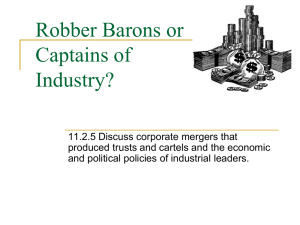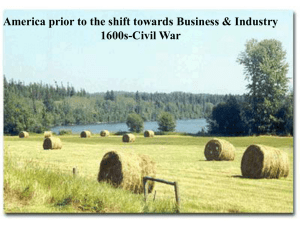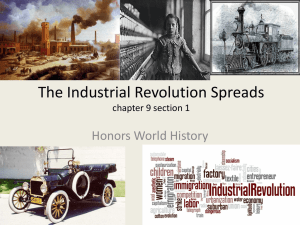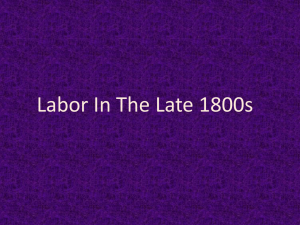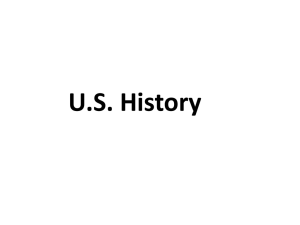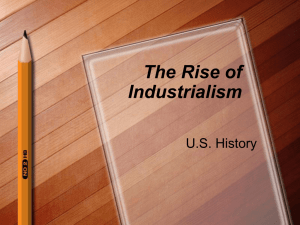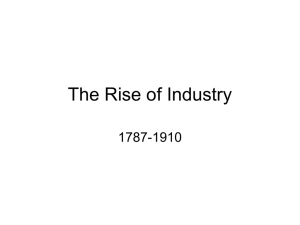A New Industrial Age - Madison County Schools
advertisement
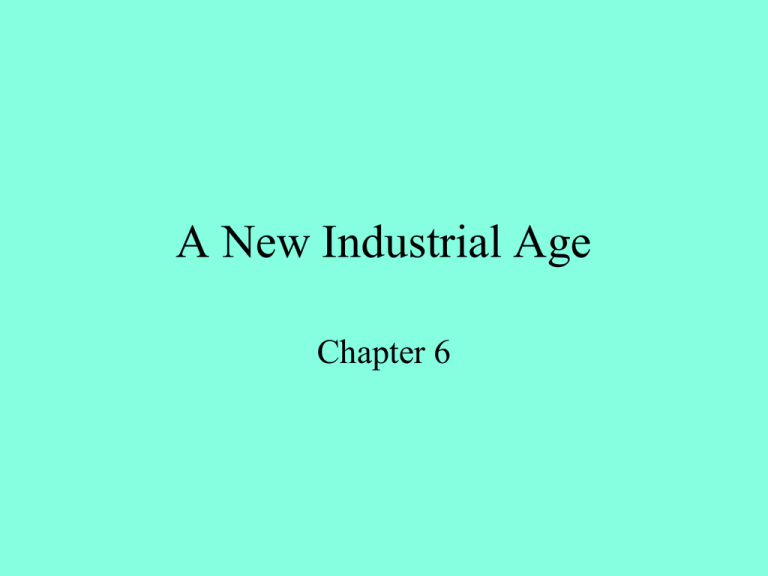
A New Industrial Age Chapter 6 The Gilded Age • Thin layer of prosperity covered the poverty and corruption of society. • Great for industrialists, bad for immigrants, farmers, workers. • There was a lot of abuse of power in business and government. Natural Resources Fuel Industrialization • 3 factors that led to industrial growth: 1.Wealth of natural resources – oil, coal, and iron 2.Government support for business 3.Growing Urban population that provided chap labor and markets. • Edwin Drake – drilled for oil in Titusville, PA – started oil breakthrough. • Iron ore deposits plentiful • Iron - dense, but breaks and rusts – not used a lot – ex/ RR used a thin layer on top of wood. • Steel –remove carbon from iron. Used the Bessemer Process to do this. Bessemer Process – cool air put in to hot iron to remove the carbon. Look at map page 231 – Pittsburgh - # of steel mills. • New Uses for Steel – RR – biggest customers of steel. – barbed wire, farm machinery – steel could break through tough soil. – Buildings and bridges – Brooklyn Bridge, skyscrapers – 1st one was the Chicago Insurance Building in Chicago. 10 stories tall. These led to upward growth in cities. Inventions Promote Change • Inventions began to have an impact on daily life. • Electricity - Thomas Edison - light bulb. He later invented an entire system to distribute electricity – central power station • George Westinghouse - instead of the costly direct current Edison used, he came up with an alternating current that was cheaper and more efficient. • ***This changed business. Allowed many machines to operate. Factories could now locate outside of cities and away from the water sources they had always relied on. • In homes – time saving appliances, like the refrigerator. Inventions Change Lifestyles • Christopher Sholes – typewriter 1867 • Alexander Graham Bell – telephone • Inventions changed jobs at home for women too. Women no longer needed to make clothes because now factories were making them. Factories were also making food that was once grown on farms – canned goods. The Age of Railroad • Transcontinental RR – spanned the nation. Central Pacific and Union Pacific RR’s. • Changes in railroads overtime included the use of steel rails - safer and could hold heavier loads. Standard gauge of track width - eliminated changes from one line to another. Westinghouse air brakes contributed to efficiency and safety. “Pullman Palace Cars” – traveling hotels. • 1869 – RR set 4 time zones – Eastern, Central, Mountain, and Pacific • 1883 – RR and towns synchronized watches • 1884 – worldwide time zones incorporated RR zones • 1918 – Congress adopted RR times • Growth of RR - growth of towns - new markets. Some towns specialized in a product – Chicago – meat, Minneapolis – grain. Credit Mobilier (Corruption) • The growth of the RR’s did lead to corruption • Union Pacific RR stockholders formed a construction company called Credit Mobilier. Gave this company a contract to lay track at 2 – 3 times the actual cost. Pocketed the profit. Donated shares of the profit in stock to members of Congress. • Made about $23 million. The Grange and the RR RR Abuses 1. misuse of land grants – sold to other businesses, not farmers – “Scratch my back…” 2. fixed prices – esp. with storage 3. different rates Granger Laws – laws passed by state legislatures to protect farmers • 1877 – Munn v. Illinois – Supreme Court upheld Granger Laws – allowed states to regulate businesses within its borders, including RR. • Wabash v. Illinois – Munn overturned – only federal government can regulate interstate trade Interstate Commerce Act • 1887 • Re-establishes the fed. govt. right to supervise RR. • Set up Interstate Commerce Commission (ICC) to do that. • ICC couldn’t regulate RR b/c too many and met resistance. Andrew Carnegie • one of the first industrialists to make his own fortune. • 1873 – entered steel business • 1899 – Carnegie Steel produced more steel than all the factories in Great Britain. • Management practices: 1. Made better products cheaper – incorporated new machinery and techniques like accounting systems – track exact costs. 2. Got talented people to work for him by offering them stock in the company – he encouraged competition among his assistants. • He worked at controlling as much of the steel industry as possible – vertical integration – bought out suppliers – included the coal fields, iron mines, ore freighters, and RR lines. He also practiced horizontal integration – buying out those companies that were competition. Social Darwinism and Business • Social Darwinism strongest businesses will survive and the government shouldn’t regulate. Growth and Consolidation – ways to eliminate competition • 1. Mergers – buying out the stock of another corporation. • 2. Monopoly – when a company got rid of all competition – had complete control over its production, wages and prices. • 3. Holding Company – set up to do nothing but buy out the stock of other companies. J.P. Morgan, a banker, made U.S. Steel the most successful holding company. Bought out Carnegie Steel in 1901. John D. Rockefeller • Standard Oil Company – formed trusts with competing companies. • 4. Trusts – members turned their stock over to a board of trustees who ran the companies as one large corporation. Companies in return earned profits. Rockefeller used this to gain control of the oil industry. • Drove competitors out of business by selling his oil at lower prices. When competition was gone he raised prices to make a profit. Sherman Antitrust Act • 1890 – Sherman Antitrust Act – made it illegal to form a trust that interfered with free trade between states or with other countries. • Wasn’t easy to enforce, and eventually it was overlooked. Business Boom Bypasses the South • North – natural and urban resources plentiful. • South – lack of capital, people unwilling to take a financial risk. Mostly agriculture, at the mercy of the RR, high tariffs on imported goods, and lack of skilled workers. • The South remained mostly rural. Industry was hard to start in the South. Railroad owners charged higher prices on goods shipped from the South to the North. Labor Unions Emerge • Why?? Low wages, unsafe working conditions, drew workers together to try to improve conditions. • No vacation, sick days, workers comp, etc. • Working conditions bad – dirty, poorly ventilated, led to injuries. • Repetitive takes on sometimes faulty equipment. • In 1882 675 workers killed. • Low wages - whole families had to work, even children as young as 5. Early Labor Organizing • National Labor Union – 1st large-scale national organization of labor – William H. Sylvis. Included skilled and unskilled. Membership – 640,000. Lasted 6 years 1869 –Terrance Powderly – Knights of Labor – open to all workers – skilled and unskilled, men and women. – Strikes as last resort. – Goals - equal pay for equal work, 8 hour day, and no child labor. • Samuel Gompers – started American Federation of Labor – (AFL) – focused on collective bargaining – negotiations between labor and management where they would reach agreements on wages, hours, etc. Organized skilled male workers in smaller unions under the umbrella of the AFL. Strikes Turn Violent • The Great Strike of 1877 - Baltimore and Ohio RR workers protest 2nd wage cut in 2 months. Stopped working. 50,000 miles stopped working for over a week. RR owners asked President Hayes to step in – he sent in federal troops to stop the strike. Companies now relied on federal and state troops to repress labor unrest. • The Haymarket Affair – 1886 - fight between strikers (Knights of Labor) and scabs – Police were called in to break it up - shots were fired. – Rally -bomb - gunfire erupted • After this, strikes were not successful (public began to turn against the labor unions) and the Knights of Labor disappeared. • The Homestead Strike – Carnegie Steel – wage cut. – Pinkerton’s - there was a battle, some detectives and workers were killed, and the plant closed. – The National Guard was called in. – The union lost a lot of support • The Pullman Company Strike – laid off workers and cut wages – Went on strike, it turned on violent. – President Cleveland sent in troops. Triangle Shirtwaist Factory fire • New York City – 1911. • Fire spread quickly through 8 – 10th floors. • Company had locked doors to prevent theft and there was no sprinkler system. • 146 women died.



